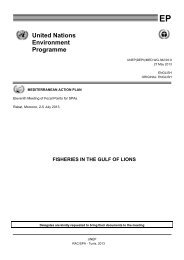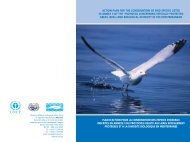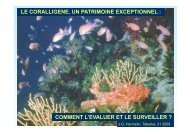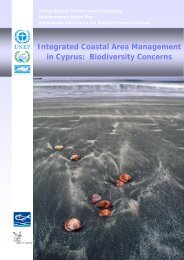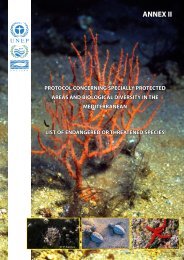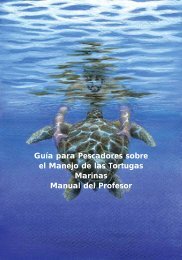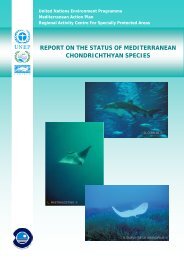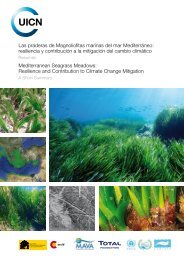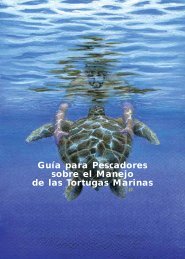Proceedings of the Second Mediterranean Symposium on Marine
Proceedings of the Second Mediterranean Symposium on Marine
Proceedings of the Second Mediterranean Symposium on Marine
You also want an ePaper? Increase the reach of your titles
YUMPU automatically turns print PDFs into web optimized ePapers that Google loves.
PROCEEDINGS OF THE SECOND MEDITERRANEAN SYMPOSIUM ON MARINE VEGETATION (ATHENS, 12-13 DECEMBER 2003)<br />
60<br />
Fig. 3. Dendrogram depicting mutual floristic similarities <str<strong>on</strong>g>of</str<strong>on</strong>g> floras <str<strong>on</strong>g>of</str<strong>on</strong>g> <str<strong>on</strong>g>the</str<strong>on</strong>g> three FAO sectors.<br />
Fig. 4. Dendrogram depicting mutual chorological similarities <str<strong>on</strong>g>of</str<strong>on</strong>g> floras <str<strong>on</strong>g>of</str<strong>on</strong>g> <str<strong>on</strong>g>the</str<strong>on</strong>g> three FAO sectors.<br />
In <str<strong>on</strong>g>the</str<strong>on</strong>g> last years, three check-lists <str<strong>on</strong>g>of</str<strong>on</strong>g> <str<strong>on</strong>g>Mediterranean</str<strong>on</strong>g> Fucophyceae, Chlorophyceae and<br />
Ceramiales, based <strong>on</strong> references since 1950, were compiled by Ribera et al. (1992),<br />
Gallardo et al. (1993) and Gómez Garreta et al. (2001), respectively. From such papers<br />
we drew lists <str<strong>on</strong>g>of</str<strong>on</strong>g> Fucophyceae, Chlorophyceae and Ceramiales <str<strong>on</strong>g>of</str<strong>on</strong>g> five <str<strong>on</strong>g>Mediterranean</str<strong>on</strong>g> areas<br />
delimited as follows: (SPA) Spain, (FRA) France, (GTR) Greece and Turkey, (LEL) Libya,<br />
Egypt and Levant States (Syria, Leban<strong>on</strong> and Israel), (MAT) Morocco, Algeria and Tunisia.<br />
Then, <str<strong>on</strong>g>the</str<strong>on</strong>g> above lists were compared with <str<strong>on</strong>g>the</str<strong>on</strong>g> corresp<strong>on</strong>ding systematic lists <str<strong>on</strong>g>of</str<strong>on</strong>g> <str<strong>on</strong>g>the</str<strong>on</strong>g> Italian<br />
coast (ITA). From this comparis<strong>on</strong> it resulted that <str<strong>on</strong>g>the</str<strong>on</strong>g> number <str<strong>on</strong>g>of</str<strong>on</strong>g> specific and infraspecific<br />
taxa accepted for <str<strong>on</strong>g>the</str<strong>on</strong>g> <str<strong>on</strong>g>Mediterranean</str<strong>on</strong>g> Sea is 243 Fucophyceae, 178 Chlorophyceae and<br />
260 Ceramiales (Table 3). Italy and France resulted <str<strong>on</strong>g>the</str<strong>on</strong>g> richest in species areas with 215<br />
(82.7%) and 214 Ceramiales (82.3%), 205 (84.3%) and 157 (64.6%) Fucophyceae,<br />
154 (86.5%) and 122 (68.5%) Chlorophyceae, respectively. C<strong>on</strong>versely, <str<strong>on</strong>g>the</str<strong>on</strong>g> LEL area<br />
resulted <str<strong>on</strong>g>the</str<strong>on</strong>g> poorest in species with <strong>on</strong>ly 128 (49.2%) Ceramiales, 74 (30.4%)<br />
Fucophyceae and 72 (40.4%) Chlorophyceae (Table 3). Species comm<strong>on</strong> to all areas are<br />
90 Ceramiales (34.6%), 54 Fucophyceae (22.2%) and 48 Chlorophyceae (29.9%) while<br />
very few resulted <str<strong>on</strong>g>the</str<strong>on</strong>g> sole <strong>on</strong>es: 12 (4.6%), 30 (12.3%), 21 (11.7%) at Italy; 3 (1.1%),




